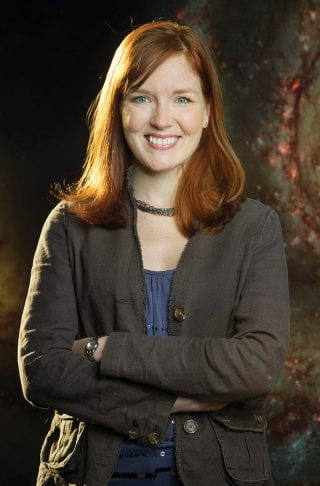Alumna Helps NASA Launch New Space Telescope
 NASA will launch its new James Webb Space Telescope this fall, with Oct. 31 scheduled as the launch readiness date. The Halloween date seems strangely appropriate, because, as Honors College alumna Amber Straughn said “launch is always scary — you know, it’s a controlled explosion; you’re putting your spacecraft on top of a bomb, essentially.”
NASA will launch its new James Webb Space Telescope this fall, with Oct. 31 scheduled as the launch readiness date. The Halloween date seems strangely appropriate, because, as Honors College alumna Amber Straughn said “launch is always scary — you know, it’s a controlled explosion; you’re putting your spacecraft on top of a bomb, essentially.”
“But for us, the scariness doesn’t stop after we separate from the launch vehicle, because then we have weeks of these extreme deployments,” said Straughn (B.S., physics, magna cum laude, ’02), who serves as deputy project scientist for communications on the project.
In an exquisite extraterrestrial ballet, the four-story-tall telescope will unfold, followed by a tennis-court-sized sunshield that will keep the spacecraft temperature below 50 degrees Kelvin (−369.7 degrees Fahrenheit), necessary for infrared observations of the distant universe. Then the gold-plated beryllium mirror, 21 feet in diameter and composed of 18 hexagonal segments, will deploy and begin to collect the light needed to capture images from distant space and time never glimpsed before.
It will be about six months after launch before the first scientific images come back from the telescope, and Straughn cannot wait. Her research focuses on how stars and black holes form in distant galaxies and how those processes change over time. “We’ve never been able to see the first galaxies born after the Big Bang. … It’s sort of like we’re missing that first chapter in the story of the universe. We’re talking about looking back in time, over 13 and a half billion years into the past, to see those first galaxies.”
The Webb telescope will also shed light on planets and moons in our solar system and exoplanets that orbit other stars. “So in that sense, Webb is definitely the next step in our search for habitable planets in the universe,” Straughn said.
Straughn was raised on a watermelon farm in Bee Branch, Arkansas, and was first in her family to earn a college degree. She said the U of A provided her first opportunity to stretch intellectually and find like-minded people who are passionate about physics. She also experienced her “first brush with NASA” as an undergraduate — she was part of a team that developed a reduced gravity flight experiment that resulted in a trip to Johnson Space Center. Now, 15 years into her career with NASA, she’s most excited about what she doesn’t know — yet.
“As a scientist, I think the most exciting prospect for me is this idea, really this guarantee, that we’ll discover things about the universe that completely surprise us. We’ll find things that we had never dreamed of, and we’ll find answers to questions that we haven’t even thought to ask yet.”
For more information visit the James Webb Space Telescope site at jwst.nasa.gov.
Kendall Curlee
479-575-2024 // kcurlee@uark.edu

